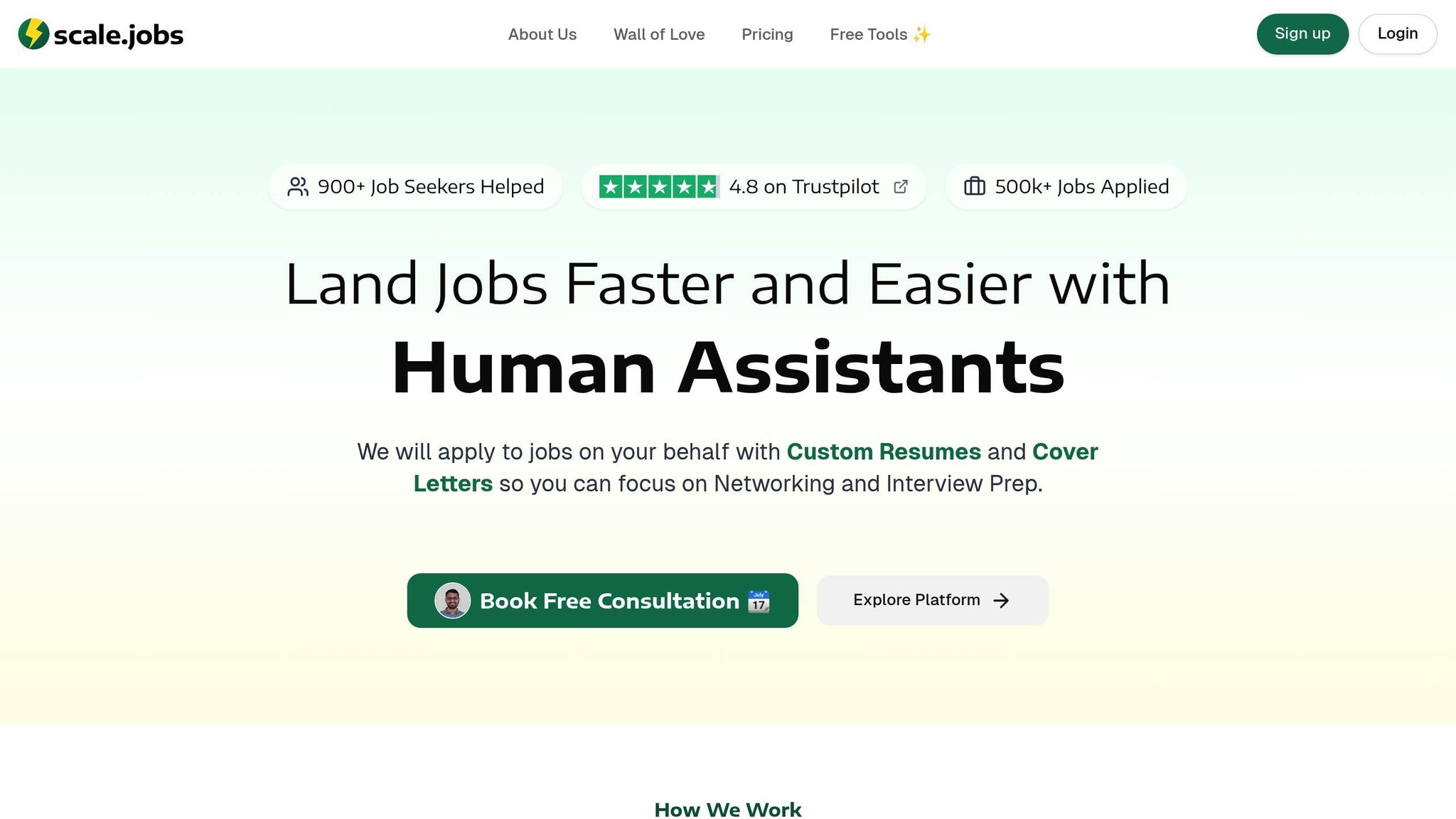Decision Agility in Job Hopping
Streamline your job search process and boost your success rate by outsourcing repetitive tasks to focus on networking and interviews.

Looking for a faster way to land your next job? Manual job applications can take hours, slowing you down and leading to missed opportunities. Here's how you can save time and improve your job search:
- Manual applications: Tailoring resumes, writing cover letters, and filling forms take up to 15+ minutes per job.
- Challenges: Time constraints, rushed applications, and missed networking opportunities.
- Solution: Platforms like Scale.jobs handle repetitive tasks for $4/hour, cutting job search time from 5 months to 1–3 months.
Quick Comparison:
| Metric | Manual Applications | Scale.jobs |
|---|---|---|
| Time per Application | 15+ minutes | Managed by assistants |
| Average Job Search | ~5 months | 1–3 months |
| Success Rate | Variable | 93% placement in 3 months |
Job-Hopping vs. Staying Loyal: Making the Right Career Move ...
1. Manual Job Applications
Applying for jobs manually can slow down decision-making for job seekers, especially those aiming to explore multiple opportunities at once. The process is time-consuming, often requiring hours each day for repetitive tasks.
Here’s what it typically involves:
- Tailoring resumes for each role
- Writing customized cover letters
- Filling out lengthy application forms
- Following up with employers
These steps can create delays, making it harder to respond quickly to promising opportunities. Spending so much time on each application can also lead to rushed efforts, increasing the chances of errors.
| Challenge | Impact on Job Seekers |
|---|---|
| Time Constraints | Limits ability to apply to multiple roles |
| Quality Issues | Errors from rushed applications |
| Slow Market Response | Missed opportunities due to delays |
| Lost Opportunities | Reduced time for networking or interview preparation |
On top of this, the costs of premium job boards and tracking tools add financial strain to an already inefficient process. The lag between finding a job posting and submitting an application can make it harder to follow up in a timely manner.
This is especially tough for professionals who need to switch jobs quickly, like those affected by layoffs or urgent workplace challenges. For them, manual applications can significantly extend the job search timeline.
Understanding these challenges highlights the need for faster, more efficient methods that don’t sacrifice quality or personalization.
2. Scale.jobs

Scale.jobs simplifies the job application process by assigning repetitive tasks to skilled virtual assistants, allowing job seekers to focus on networking and preparing for interviews.
The platform tackles common obstacles with several key features:
| Feature | Benefit |
|---|---|
| 12-24 Hour Applications | Quick responses to opportunities |
| Custom Resumes | High-quality, tailored applications |
| Application Tracking | Clear visibility into progress |
| Dedicated Support | Strategic career guidance |
Unlike manual applications that can slow you down, Scale.jobs cuts the time spent searching for roles significantly. At just $4/hour, it offers excellent cost-efficiency. Users have reported a 200x return on investment thanks to quicker placements and higher salaries.
"Applying to jobs every day has been super daunting. But now with Scale.jobs, one can apply to hundreds of jobs per day while focusing on interview preparation." – Sona Tambe
The platform also includes tools like an ATS Checker, Salary Predictor, Interview Questions Predictor, and Job Applications Tracker to make your job search even more effective. Results speak for themselves: 70% of users secure refunds within 30 days due to successful job placements.
"Scale.jobs has been an excellent help in applying to a high volume of jobs, which otherwise would be very time-consuming... They also keep adding new features, like the networking tool." – Shobhit Datta
By combining human expertise with streamlined processes, Scale.jobs allows job seekers to focus on strategic career decisions. With 47% of roles secured through Scale.jobs applications and 44% through personal networking, it supports a balanced approach to job hunting.
These efficiencies set the stage for a closer look at the platform's advantages and limitations.
Benefits and Limitations
The following table breaks down key metrics to compare manual job applications with the Scale.jobs platform:
| Metric | Manual Applications | Scale.jobs |
|---|---|---|
| Time per Application | 15+ minutes | Managed by assistants |
| Average Job Search Duration | ~5 months | 1–3 months |
| Success Rate | Variable | 93% placement within 3 months |
| Focus Distribution | Split between applications and networking | Primarily on interviews and networking |
| Cost Structure | Free but time-intensive | $4/hour with refund option |
These figures show how a streamlined application process can lead to quicker decisions for job seekers. Users have reported a 200× ROI, with faster placements leading to average salary increases of $20,000 and potential gains reaching $30,000.
However, the upfront cost of Scale.jobs can be a drawback for some. Hemil P shares:
"Price point maybe on the expensive side, but you pay for the time it saves to create accounts on several sites and apply jobs."
By shortening the job search by 40%, the platform enables professionals to transition faster in competitive markets, especially after layoffs or workplace challenges. Its tools - such as the ATS Checker, Salary Predictor, and Interview Questions Predictor - help users evaluate opportunities more effectively.
Anuva Agarwal highlights this advantage:
"I would recommend trying out scale.jobs to anyone looking to make more time in their schedule for interview prep and networking, so that the repetitive portion of job application process can be outsourced. I personally feel it's good value for money."
This comparison emphasizes how increased efficiency can lead to smarter career decisions.
Key Takeaways
Streamlining the job application process can help job seekers achieve faster and more effective results by focusing on efficiency and smart strategies.
Impact on Time Management
- Cutting search time from 5 months to just 1–3 months is possible with optimized strategies.
- Nearly half of successful placements (47%) come from direct applications, while 44% are the result of networking efforts.
- Outsourcing application tasks allows job seekers to dedicate more time to preparing for interviews, improving their chances of success.
These time-saving techniques help job seekers act quickly and strategically in their search.
Placement Success Rates
- Strategic methods can lead to a 93% placement rate within 3 months.
- Balancing consistent applications with networking significantly speeds up job search results.
- Combining personal outreach with a structured application process creates a powerful dual approach.
These numbers highlight how a well-planned strategy can lead to measurable career progress.
Practical Recommendations
- Assess the return on your time investment. For example, Scale.jobs reports a 200x return on investment for its users.
- Use tools like ATS checkers and salary predictors to make smarter decisions about job opportunities.
- Focus on high-impact activities like networking and interview preparation while maintaining a steady volume of applications.




